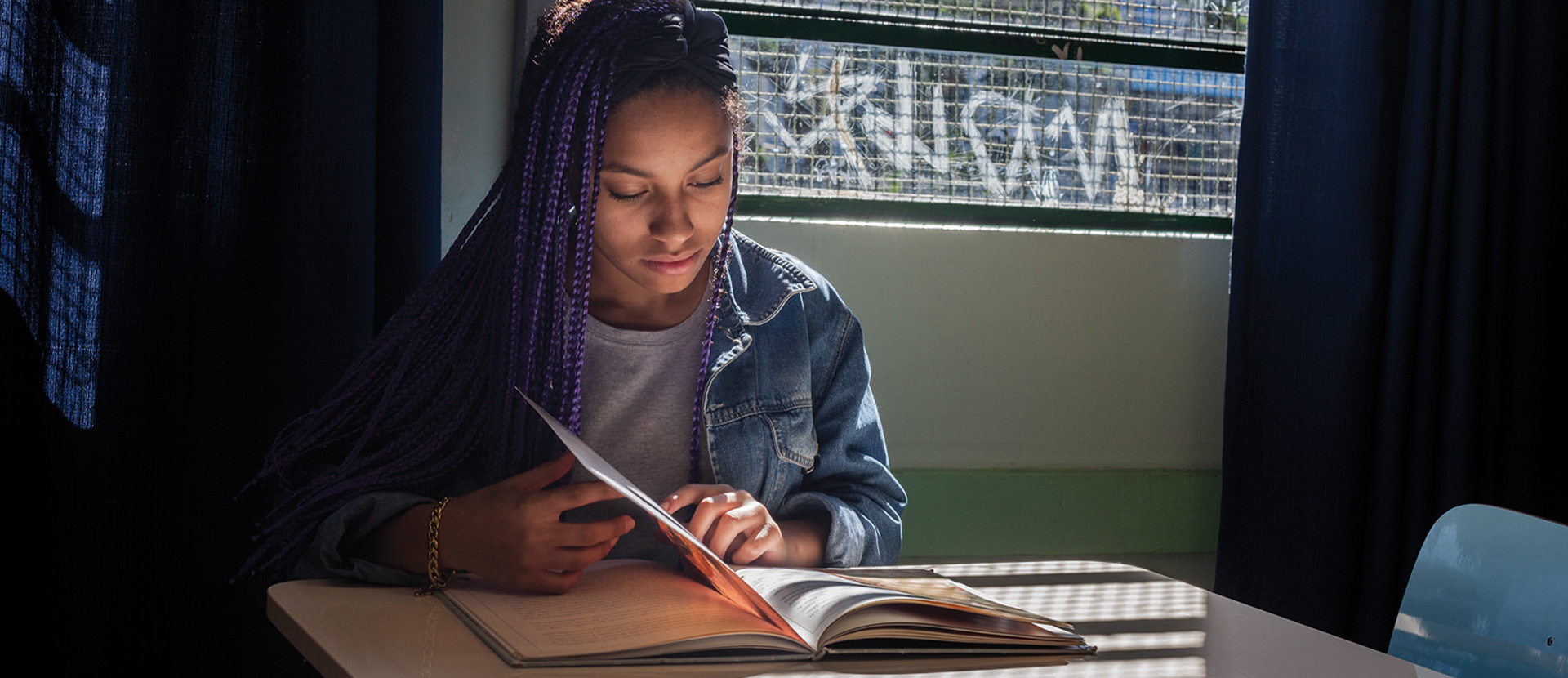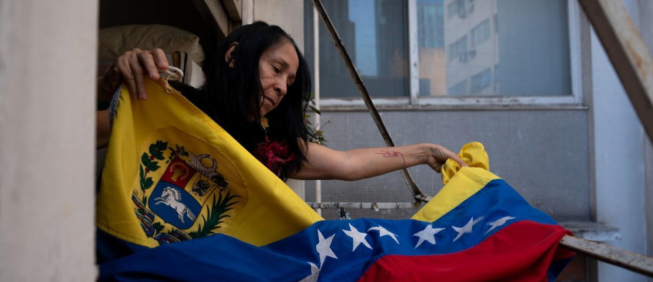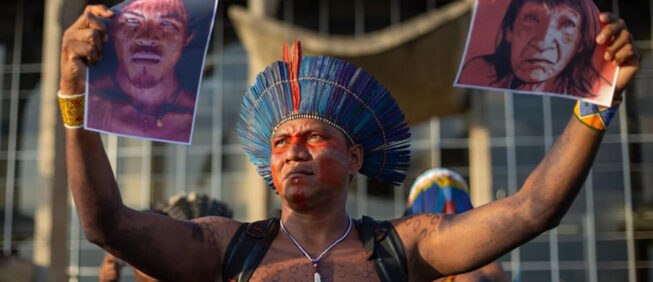Instituto Unibanco
School management for equality: paths to an anti-racist education
| Brazil |
11 de December de 2019
translated by Edmund Ruge
School management for equality: paths to an anti-racist education
Following the ratification of the 1988 constitution, basic public education experienced a series of advances. While these may not have been as swift and intense enough to guarantee rights for all to this day, they were advances nonetheless.
The example that best demonstrates this progress is that of elementary school, which was practically universalized, and saw consistent upward trajectories in major indicators. In 2018, for example, 98% of students between the ages of 6 and 14 were enrolled in a grade level adequate for their age group1 TODOS PELA EDUCAÇÃO; EDITORA MODERNA, 2019, p. 30.. The Basic Education Development Index (Ideb) for the initial years2The main educational quality indicator for Brazil. The Ideb was created in 2007 and gathers data from two central areas: school movement (graduation, drop-out etc), and performance averages. It is calculated from data on grade passage, obtained from the national school census, and from average performance rates on evaluations from the Anísio Teixeira National Institute for Educational Studies and Research (Inep), the Evaluation System for Basic Education (Saeb) at the national and state levels, and the Prova Brasil test for cities. of this stage of teaching in the public school network reached 5.5 in 2017, having risen from 3.6 in 20053TODOS PELA EDUCAÇÃO; EDITORA MODERNA, 2019, p. 64. — continuing toward the goal set for the country, 6.0, by 2021.
And yet, the country still carries with it (and renews annually) many of its historic debts. High levels of illiteracy (in 2018, 6.8% of the population 15 years old or older was illiterate)4 Ibid, p. 81, persistently high truancy rates, drop-out rates, and age-grade distortion (of every 100 students that begin school, only 64 complete high school by the expected age)5 Ibid, p. 16, and a level of learning in high school that is both low and stagnant (the Ideb for this level of basic education rose from 3.4 in 2015 to only 3.8 in 2017, remaining far from its goal)6 Ibid. p. 64, are all categorical examples.
The situation is even graver if we break down the data by race, gender, territory, etc.
The Law of Directives and Bases for National Education (Law number 9394/1996), which adheres to and is founded in international pacts and conventions, highlights these challenges. Further changes made to the law reinforce its commitments. The inclusion of early childhood education and high school as mandatory schooling stages (Law 12796/2013), the obligatory teaching of Afro-brazilian and indigenous history and culture (Laws 10639/2003 and 11645/2008) and the establishment of the Fund for Maintenance and Development of Primary Schooling and the Valuing of Teaching (Fundef), and later the Fund for Maintenance and Development of Basic Education and the Valuing of Education Professionals (Fndeb) (Laws 9424/1996 and 11494/2007) — that made possible, albeit with room for improvement, a gradual increase in financing for public education in Brazil — are formative examples that should strengthen paths toward advancement.
Despite all of this, the current context — the questioning of plural and democratic values that provided grounding for these advances over the last three decades; the worsening in conditions of public education offerings; all amid the 2015-2016 economic crisis — has made the task of taking on remaining challenges in Brazilian educational policy all the more difficult. This is particularly true of the need to prioritize and target actions to the benefit of historically discriminated and excluded populations.
In this context, driven by the theme of this edition of Peripheries (potency and challenges for public schools), and in line with our institutional commitment to valuing public high schools, this text will address the inequalities (principally racial inequalities) in public high schools, and how management, through Instituto Unibanco’s framework, can contribute to tackling these issues.

II
Management and confronting inequality
Racism is structural in Brazilian society, and as part of a long socio-historic process7See Ramos (1958); Nascimento (1978), Hasenbalg (1979), Gonzalez e Hasenbalg (1982); Hasenbalg , it is strengthened and reproduced in public education, sustaining the gap that separates the extent to which rights are guaranteed for white and black populations, from access to education to successful graduation.
From a racial perspective, it is possible to observe the size of this gap in all educational indicators. The data that follow address only high school, and may be found and analyzed at the Education Observatory, developed by Instituto Unibanco (observatoriodeeducacao.org.br).
The passing rate among white students was 84.4% and 80.1% for black students. Failure rates exhibit the same difference: 10.3% among whites and 11.9% for blacks. And just as in the case of these two performance indicators, the drop-out rate for black youth was 7.9% and 5.2% for white youth8Data elaborated by Instituto Unibanco based in information from national school census 2018, Inep.
As one of the principal consequences of lack of access, failures, and drop-outs, age-grade distortions demonstrate the scale of this inequality. Measured by the rate of discrepancy between age and grade (the portion of students two or more years behind the ideal age for their respective grade), for black students the rate was 21.1%, and for whites, 11.3%.9Data elaborated by Instituto Unibanco based in information from national school census 2018, Inep

In proficiency levels, the difference continues. Black students had an average grade of 256 in the Basic Education Evaluation System (Saeb), while white students scored 270.10Data elaborated by Instituto Unibanco based in information from Saeb 2017, Inep

Scores for Portuguese Language and Math classes on the Saeb vary from 0 to 500 points. In order to compare the disciplines and ascertain if the students reach an adequate level of learning, it is possible to analyze the distribution of students through patterns in quiz performance. On the Saeb scale, these patterns are designated as: below standard, standard, appropriate, and advanced. Being white or black should not be a condition for better or worse performance. However, 44.9% of black students found themselves at a below-average level for Portuguese Language class, while the same for white students was 33.5%, for example.11Data elaborated by Instituto Unibanco based in information from Saeb 2017, Inep
Fonte: Elaborado pelo Instituto Unibanco com base em informações do Saeb 2017, INEP.

As a sum of this, only 38.9% of black students graduated from high school with the expected age (19 years old). Among white students, the figure was 53.9%.12 From the national household survey- Pnad, IBGE. Available at: <https://educacaoemnumeros.observatoriodeeducacao.org.br>. Accessed: Oct 10 2019
It is impossible to confront such a structural problem without a strategy, translated into a conscious, consistent, systematic plan that advances as it overcomes previous problems. That is to say, management, in the vision of Instituto Unibanco, is a necessary condition — albeit insufficient by itself — for promoting the jump in educational quality that Brazil needs in order to fight the inequality facing the country.
Management is a disputed concept, assuming different meanings depending on the perspective adopted13 Oliveira; Menezes, 2018. In our view, “management is a process of organizing and mobilizing efforts, directing them toward reaching an objective data point.” As such, its importance is structural. “Without organization, articulation, and mobilization around common objectives, how do we know where we wish to go and verify whether or not we are on the right path? Management brings intention to effort and direction planned for change.”14nstituto Unibanco, 2019
For Instituto Unibanco, the great driving factor, already verified in international experiments, is the strengthening of a culture for the advancement of education. “Often it is not easy to recognize that that which is practiced for years may not be the best for students, and that improvements are necessary. Programs that do not consider the challenge of learning new things and the importance of integration between stages in order to evaluate the implementation of public policies will not turn out well. It is fundamental that the environment be propitious to the collective construction of knowledge, giving value to diversity of perspectives and deliberative decision-making processes.15 Ibid
In this way, the model of management proposed by Instituto Unibanco is directed toward the deliberate and consequential search for improved educational results and also the guarantee of conditions for continued advancement. This perspective is structured in three pillars.
The first is not losing sight of our focus on development in students in a day-to-day setting, allowing time for management to dedicated to lesson plans and to the adoption of other practices with greater potential of reaching, in a positive way, children and youth.
As such, the comprehensive development of students must be at the center of the educational process. “We understand comprehensive development to be that which makes viable learning experiences capable of preparing youth for adult life, acting in multiple dimensions: physical, intellectual, social, emotional, and symbolic. It is to this end that the energy and efforts of schools and teaching networks should be directed.”16 Instituto Unibanco 2019
It is also fundamental to maintain an open an analytical attitude in terms of practice, and critically consider what is being done. “Learning and doing differently require study, exchange, and experimentation. When a new practice proves itself to be successful, it is fundamental to have the discipline to register it and disseminate it. These are attitudes of constant learning based in practice that form the second pillar of continuous advancement.”17 Ibid
Other bodies that make up this network, including secretariat level and regional bodies, must construct a network of orientations, rules, and support, which much have internal coherence in order to function. “Taking on co-responsibility means doing your part in the most effective way possible.”18 Ibid
With the practices of managers at different levels sustained by these pillars, Instituto Unibanco hopes to influence action, and later, the culture of management, an essential point for combating the discrimination that perpetuates the inequality cited earlier. Without recognizing racism, for example, and without anti-racism as a shared value between these actors, it will be very difficult to advance toward equity.
This means that, most likely, acquiring and applying knowledge of varied educational practices, which can be applied to the diverse needs of students, will allow us to confront inequalities of racial nature. However, this alone is insufficient. It is necessary to intervene in this reality from the perspective of identity characteristics as well, recognizing them, giving them value, and combating all that subjugates them.
In this way, Instituto Unibanco considers that, in order to be truly effective, management in education (of networks, of schools, and of the classroom itself) must consider diversity and historical and structural inequalities that make up schools and the teaching system as a whole. It is only with an eye attuned to the processes that produce inequalities that a manager will be able to offer equal conditions for development to his or her students.
In order to promote this vision, stimulating cultural change is essential, guaranteeing respect for values and basing actions in these values. One of these is maintaining high expectations for all. “Once the right to education becomes universal, educators and managers must truly believe in the potential that all students bring with them and act in a way that guarantees them the conditions necessary for their development, in a non-discriminatory way. Furthermore it is necessary that the confrontation of inequalities be a point of direct attention inside the school, in a way that allows us to promote, effectively, justice in schools.”19 Instituto Unibanco, 2019
For such a change to occur, differentiated actions within all schools are necessary. In every classroom, for example, it is possible to identify students that experience difficulties in certain disciplines and achieve good or excellent grades in many others. Schools must deal with these situations, search for focused, specific alternatives, such that this student is able to overcome these challenges.
In this context, one of the cultural barriers that is most problematic is that of grade failure. Impeding that a student moves on to the next grade because of two or three failing grades, even if he or she has done well in the other 15 disciplines, is probably not the best decision. At the same time, it is necessary, yes, to wait until that student improves his or her performance in these areas.
Schools that function well search for alternatives, work with a greater focus on projects, or work in a more interdisciplinary fashion, not because this approach is technically superior, but because these schools have created environments in which professors from different subjects value one another and work together in order to overcome specific difficulties.
Another essential value is diversity. “Welcoming cultural, identity, and thought diversity is democratic, inclusive, and potent for the designing of better solutions. Rather than paralyzing before differences and disagreements, these should be used as forces of creation. To this end, we understand it to be necessary to recognize the other in order for us to identify the existence of different cultural perspectives, accept these differences, and coordinate them. Heterogeneity should be considered. Suffice it to say that the ideal of advancement in education extends to all students, independent of their race, gender, or socioeconomic environment. Given that education is a human right, no one can be left behind. Equality is an inalienable value and must be pursued.”20 Ibid
In this way, leaving no one behind implies believing that all students have potency, and consequently, that it is essential to recognize and give value to identities and differences. Only then can discriminatory and exclusionary understandings, already naturalized by society, be confronted.
An unavoidable step for this to occur is recognizing diversity as a key variable and producing a logic of social policy from this platform. But this is not enough. Public schools must also produce an agenda in which this recognition is positive, in which diversity takes on a central position in Brazilian educational policy. As such, it is necessary to produce not only affirmative action, but continuous affirmation in the process.
Therefore, based in the values of maintaining high expectations for all and valuing equality, the management of public education will be able to ascertain, at all moments, to what extent inequality is growing or not. Only then will we have an understanding of whether or not education is straying from the path of the production of a public good, which requires reaching a level of excellence in equity. This is public education’s essential vocation: produce excellence in equity. This is what creates value, and what creates a field of public responsibility among principals, teachers, with the school community, and with society as a whole. And this vocation can only be translated into practice by schools that are public, republican, and secular.

III
Management for equality: promoting and searching for solutions
“Efficiency requires the best possible use of resources, making it possible to accomplish more. Efficacy refers to the accomplishment of that which was proposed, for example, holding classes, with students present, and services provided. But it is not enough to provide services if they do not improve the lives of all citizens, and this refers to the principle of effectiveness. Effectiveness in education occurs when we improve results in terms of access, permanence, learning, and comprehensive development.
Furthermore, the fact of public administration acting for the promotion of the common good brings nuances to the application of the principles of efficiency, efficacy, and effectiveness, which must be combined with the values of equity and justice. In public management, it is impossible to ‘achieve better results’ if this means maintaining or generating social inequality.”21 Instituto Unibanco 2019
In this perspective, today, education management in Brazil must continue advancing to find new paths that achieve effectiveness and improvements in educational results at the same time that they confront and reduce inequality.
17 years after the passage of Law 10,683/03, we now have a generation of people that have gone from preschool to high school under a new paradigm. While the paradigm exists, it still faces various challenges to its concretization. The low institutionality of this legal landmark and its directives continues to be a challenge for Brazilian schools to this day.
In this sense, supporting school management practices directed toward the reduction of racial inequalities and the valuing of diversity is both necessary and urgent. Current research on ethnic-racial relations in education indicates that there is low participation of managers in this area22 Gomes; Jesus, 2013, which has generated a weak implementation of legal directives for the teaching of ethnic-racial relations in educational establishments. There is also an increasingly present narrative among social movements and researchers that act in this area, arguing that it is not enough to recognize the existence of racism and undertake sporadic and isolated activities on African and Afro-brazilian culture and history. This discussion requires the organization of an educational pilot project in schools.
To this end, over the last five years, Instituto Unibanco has invested in exchanges between civil society organizations with legitimacy and articulated actions for taking on the racial inequality present in the school context, pursuing the promotion and guarantee of rights for each and every one, as explained throughout this text.
In the context of this articulation, as a strategy for institutional intervention, we have launched, in partnership with the Baobá Fund for Racial Equality and the Federal University of São Carlos (UFSCar), two editions of the School Management for Equity - Black Youth Grant. For public schools and social organizations around the country with the objective of contributing to the development and implementation of inspiring practices in school management in the area of ethnic-racial relations. It is important to highlight that, in addition to this partnership, we are also in dialogue with many other important actors in this debate.23Instituto Unibanco also dialogues with, supports, and implements actions in partnership with Ação Educativa, the Brazilian Association for Black Researchers, the Instituto Maria e João Aleixo, and the Center for Studies on Work Relations and Inequality
The School Management for Equity - Black Youth Grant has already selected, in total, 20 projects from regions throughout the country over its last two editions (2014/2015 and 2016/2017). The schools involved, together with civil society organizations, proposed: acts of awareness-raising, training for educational professionals; changes in curricula; mobilization in the school community; youth engagement; combating educational inequality; valuing diversity and recognizing social, cultural, scientific, and political contributions of different peoples in the formation of Brazil.
The experience gained in these two grant cycles generated learning that has given us clues as to how to act more assertively in the debate about racial equity in the scope of school management, corroborating, indeed, what prevailing literature has already shown.
1) The initiatives point to paths for school actions in the implementation of the theme without removing the responsibility and importance of articulation with other spheres, such as education secretariats, universities, councils, social movements, etc. There are elements that depend on the engagement of schools, but others must be structured through educational public policies. Investment in a policy of teacher training directed toward ethnic-racial relations is essential.
2) The most affirmative and democratic school management contexts have made possible the implementation of more rooted and qualified actions in relation to the racial debate. Such inclusive contexts, however, depend on teachers and managers with a greater playbook and activism in the agenda of ethnic-racial relations, which can be rare in the school context. An anti-racist education demands daily and direct action in strengthening the dialogue and combating cultural exclusionary practices inside and outside schools. As such, broadening the number of actors trained in dealing with such discussions around racial relations (depersonalizing the debate) is more than necessary.
3) Discussions on the African and Afro-brazilian question should be inserted into the Pedagogical Political Project (PPP) in schools and in the educational planning for all disciplines. Actions should take into account the legal marks that situate diversity as a guiding principle for education, and thus, the process of construction of the PPP, beyond being collective, must include a consistent diagnostic of the youth that make up the school unit. The use of data and evidence around these students is fundamental for structuring consistent and effective action plans.
4) On organizing educational proposals, the institution must establish directives for valuing diversity and limiting ethnic-racial and gender discrimination, as well as integrating the participation and knowledge of families in different school events. As it is well known, the meaning attributed to education grows when a student recognizes him or herself, be it in the educational content, in the format of the activities, or even in the possibilities for occupation in the school space.
The points above are not exhaustive, but they do indicate to what extent a school manager can be a vector for the construction of a democratic and plural school space. Public schools must know the strength of diversity. But that alone is not enough. Public schools must engage, daily, in the development of actions directed towards the reduction of structural inequalities, producing continuous affirmative action in the educational process.
CARNEIRO, Sueli. Racismo, sexismo e desigualdade no Brasil. São Paulo: Selo Negro, 2011.
CARONE, I. & BENTO, M. A. S. (Orgs.). (2002). Psicologia social do racismo. Petrópolis: Vozes, 2014.
GOMES, Nilma Lino. Diversidade étnico-racial, inclusão e equidade na educação brasileira: desafios, políticas e práticas. RBPAE – v.27, n.1, p. 109-121, 2011.
HASENBALG, Carlos A. Discriminação e desigualdades raciais no Brasil. Rio de Janeiro: Graal, 1979.
HASENBALG, Carlos A.; SILVA, Nelson do Valle. Estrutura social, mobilidade e raça. Rio de Janeiro: Vértice: Iuperj, 1988.
HENRIQUES. Ricardo. Desigualdade racial no Brasil: evolução das condições de vida na década de 90. Texto para discussão nº 807, IPEA. Rio de Janeiro, 2001.
INSTITUTO UNIBANCO. Jovem de Futuro: Conceitos, ações e teoria da mudança. 2019. No prelo.
GONZALEZ, Lélia; HASENBALG, Carlos. Lugar de negro. São Paulo: Marco Zero, 1982
OLIVEIRA; MENEZES. Revisão de literatura: o conceito de gestão escolar. Disponível em:<http://www.scielo.br/scielo.php?script=sci_arttext&pid=S0100-15742018000300876>. Acesso: 31 de out. de 2019.
TODOS PELA EDUCAÇÃO; EDITORA MODERNA. Anuário Brasileiro da Educação Básica 2019. São Paulo, 2019.
RAMOS, A. G. A Redução Sociológica. [1958]. Rio de Janeiro: Editora UFRJ, 1996.









